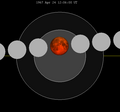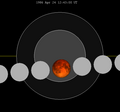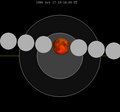October 1967 lunar eclipse
| Total eclipse | |||||||||||||||||
 The Moon's hourly motion shown right to left | |||||||||||||||||
| Date | October 18, 1967 | ||||||||||||||||
|---|---|---|---|---|---|---|---|---|---|---|---|---|---|---|---|---|---|
| Gamma | −0.3653 | ||||||||||||||||
| Magnitude | 1.1426 | ||||||||||||||||
| Saros cycle | 126 (43 of 72) | ||||||||||||||||
| Totality | 59 minutes, 45 seconds | ||||||||||||||||
| Partiality | 218 minutes, 52 seconds | ||||||||||||||||
| Penumbral | 367 minutes, 7 seconds | ||||||||||||||||
| |||||||||||||||||
A total lunar eclipse occurred at the Moon’s ascending node of orbit on Wednesday, October 18, 1967,[1] with an umbral magnitude of 1.1426. A lunar eclipse occurs when the Moon moves into the Earth's shadow, causing the Moon to be darkened. A total lunar eclipse occurs when the Moon's near side entirely passes into the Earth's umbral shadow. Unlike a solar eclipse, which can only be viewed from a relatively small area of the world, a lunar eclipse may be viewed from anywhere on the night side of Earth. A total lunar eclipse can last up to nearly two hours, while a total solar eclipse lasts only a few minutes at any given place, because the Moon's shadow is smaller. Occurring only about 22 hours before apogee (on October 19, 1967, at 8:30 UTC), the Moon's apparent diameter was smaller.[2]
This lunar eclipse was the second of a tetrad, with four total lunar eclipses in series, the others being on April 24, 1967; April 13, 1968; and October 6, 1968.
Visibility
[edit]The eclipse was completely visible over northeast Asia, western North America, and the Pacific Ocean, seen rising over Asia and Australia and setting over eastern North America and South America.[3]
 
|
Eclipse details
[edit]Shown below is a table displaying details about this particular solar eclipse. It describes various parameters pertaining to this eclipse.[4]
| Parameter | Value |
|---|---|
| Penumbral Magnitude | 2.23368 |
| Umbral Magnitude | 1.14258 |
| Gamma | −0.36529 |
| Sun Right Ascension | 13h30m10.8s |
| Sun Declination | -09°26'26.5" |
| Sun Semi-Diameter | 16'03.3" |
| Sun Equatorial Horizontal Parallax | 08.8" |
| Moon Right Ascension | 01h30m47.5s |
| Moon Declination | +09°08'55.1" |
| Moon Semi-Diameter | 14'42.8" |
| Moon Equatorial Horizontal Parallax | 0°54'00.0" |
| ΔT | 38.1 s |
Eclipse season
[edit]This eclipse is part of an eclipse season, a period, roughly every six months, when eclipses occur. Only two (or occasionally three) eclipse seasons occur each year, and each season lasts about 35 days and repeats just short of six months (173 days) later; thus two full eclipse seasons always occur each year. Either two or three eclipses happen each eclipse season. In the sequence below, each eclipse is separated by a fortnight.
| October 18 Ascending node (full moon) |
November 2 Descending node (new moon) |
|---|---|
 |

|
| Total lunar eclipse Lunar Saros 126 |
Total solar eclipse Solar Saros 152 |
Related eclipses
[edit]Eclipses in 1967
[edit]- A total lunar eclipse on April 24.
- A partial solar eclipse on May 9.
- A total lunar eclipse on October 18.
- A total solar eclipse on November 2.
Metonic
[edit]- Preceded by: Lunar eclipse of December 30, 1963
- Followed by: Lunar eclipse of August 6, 1971
Tzolkinex
[edit]- Preceded by: Lunar eclipse of September 5, 1960
- Followed by: Lunar eclipse of November 29, 1974
Half-Saros
[edit]- Preceded by: Solar eclipse of October 12, 1958
- Followed by: Solar eclipse of October 23, 1976
Tritos
[edit]- Preceded by: Lunar eclipse of November 18, 1956
- Followed by: Lunar eclipse of September 16, 1978
Lunar Saros 126
[edit]- Preceded by: Lunar eclipse of October 7, 1949
- Followed by: Lunar eclipse of October 28, 1985
Inex
[edit]- Preceded by: Lunar eclipse of November 7, 1938
- Followed by: Lunar eclipse of September 27, 1996
Triad
[edit]- Preceded by: Lunar eclipse of December 16, 1880
- Followed by: Lunar eclipse of August 18, 2054
Lunar eclipses of 1966–1969
[edit]| Lunar eclipse series sets from 1966–1969 | ||||||||
|---|---|---|---|---|---|---|---|---|
| Descending node | Ascending node | |||||||
| Saros | Date Viewing |
Type Chart |
Gamma | Saros | Date Viewing |
Type Chart |
Gamma | |
| 111 | 1966 May 4
|
Penumbral
|
1.05536 | 116 | 1966 Oct 29
|
Penumbral
|
−1.05999 | |
| 121 | 1967 Apr 24
|
Total
|
0.29722 | 126 | 1967 Oct 18
|
Total
|
−0.36529 | |
| 131 | 1968 Apr 13
|
Total
|
−0.41732 | 136 | 1968 Oct 6
|
Total
|
0.36054 | |
| 141 | 1969 Apr 2
|
Penumbral
|
−1.17648 | 146 | 1969 Sep 25
|
Penumbral
|
1.06558 | |
| Last set | 1965 Jun 14 | Last set | 1965 Dec 8 | |||||
| Next set | 1970 Feb 21 | Next set | 1969 Aug 27 | |||||
Metonic series
[edit]This eclipse is the third of four Metonic cycle lunar eclipses on the same date, April 23–24, each separated by 19 years:
The Metonic cycle repeats nearly exactly every 19 years and represents a Saros cycle plus one lunar year. Because it occurs on the same calendar date, the Earth's shadow will in nearly the same location relative to the background stars.
| Descending node | Ascending node | |||||
|---|---|---|---|---|---|---|
| Saros | Date | Type | Saros | Date | Type | |
| 111 | 1948 Apr 23 | Partial | 116 | 1948 Oct 18 | Penumbral | |

|

| |||||
| 121 | 1967 Apr 24 | Total | 126 | 1967 Oct 18 | Total | |

|

| |||||
| 131 | 1986 Apr 24 | Total | 136 | 1986 Oct 17 | Total | |

|

| |||||
| 141 | 2005 Apr 24 | Penumbral | 146 | 2005 Oct 17 | Partial | |

|

| |||||
Saros 126
[edit]It is part of saros series 126.
Lunar saros series 126, repeating every 18 years and 11 days, has a total of 70 lunar eclipse events including 14 total lunar eclipses. Solar Saros 133 interleaves with this lunar saros with an event occurring every 9 years 5 days alternating between each saros series.
First penumbral lunar eclipse: 18 July 1228
First partial lunar eclipse: 24 March 1625
First total lunar eclipse: 19 June 1769
First central lunar eclipse: 11 July 1805
Greatest eclipse of the lunar saros 126: 13 August 1859, lasting 106 minutes.
Last central lunar eclipse: 26 September 1931
Last total lunar eclipse: 9 November 2003
Last partial lunar eclipse: 5 June 2346
Last penumbral lunar eclipse: 19 August 2472
1901-2100
Tritos series
[edit]The tritos series repeats 31 days short of 11 years at alternating nodes. Sequential events have incremental Saros cycle indices.
This series produces 23 total eclipses between June 22, 1880 and August 9, 2120.
| Ascending node | Descending node | |||||
|---|---|---|---|---|---|---|
| Saros | Date Viewing |
Type chart |
Saros | Date Viewing |
Type chart | |
| 120 | 1902 Apr 22
|
Total
|
121 | 1913 Mar 22
|
Total
| |
| 122 | 1924 Feb 20
|
Total
|
123 | 1935 Jan 19
|
Total
| |
| 124 | 1945 Dec 19
|
Total
|
125 | 1956 Nov 18
|
Total
| |
| 126 | 1967 Oct 18
|
Total
|
127 | 1978 Sep 16
|
Total
| |
| 128 | 1989 Aug 17
|
Total
|
129 | 2000 Jul 16
|
Total
| |
| 130 | 2011 Jun 15
|
Total
|
131 | 2022 May 16
|
Total
| |
| 132 | 2033 Apr 14
|
Total
|
133 | 2044 Mar 13
|
Total
| |
| 134 | 2055 Feb 11
|
Total
|
135 | 2066 Jan 11
|
Total
| |
| 136 | 2076 Dec 10
|
Total
|
137 | 2087 Nov 10
|
Total
| |
| 138 | 2098 Oct 10
|
Total
| ||||
Half-Saros cycle
[edit]A lunar eclipse will be preceded and followed by solar eclipses by 9 years and 5.5 days (a half saros).[5] This lunar eclipse is related to two total solar eclipses of Solar Saros 133.
| October 12, 1958 | October 23, 1976 |
|---|---|

|

|
See also
[edit]Notes
[edit]- ^ "October 17–18, 1967 Total Lunar Eclipse (Blood Moon)". timeanddate. Retrieved 2 January 2025.
- ^ "Moon Distances for London, United Kingdom, England". timeanddate. Retrieved 2 January 2025.
- ^ "Total Lunar Eclipse of 1967 Oct 18" (PDF). NASA. Retrieved 2 January 2025.
- ^ "Total Lunar Eclipse of 1967 Oct 18". EclipseWise.com. Retrieved 2 January 2025.
- ^ Mathematical Astronomy Morsels, Jean Meeus, p.110, Chapter 18, The half-saros
External links
[edit]- 1967 Oct 18 chart Eclipse Predictions by Fred Espenak, NASA/GSFC



